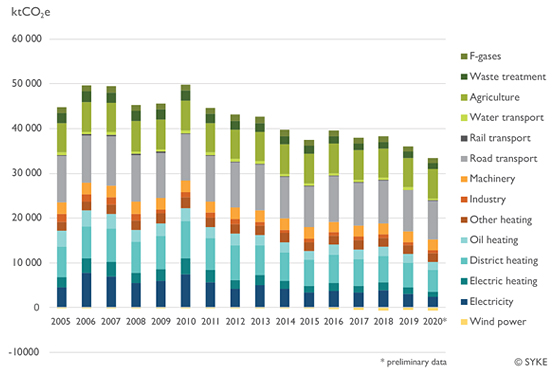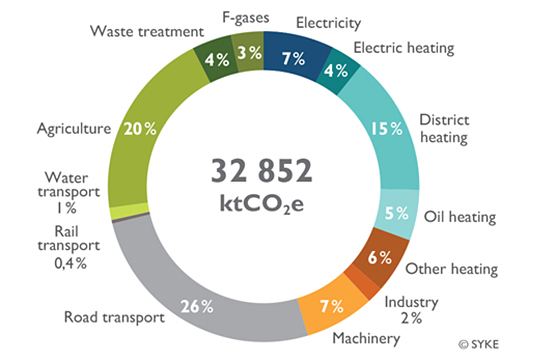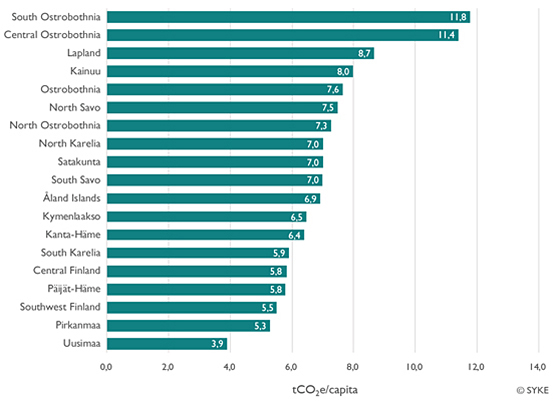Press release 2021-08-16 at 9:15

The total greenhouse gas emissions of Finnish municipalities by sector in 2005–2020. Emissions have been calculated in accordance with the Hinku calculation rules. © SYKE
According to a preliminary data calculation by the Finnish Environment Institute (SYKE), municipalities’ total climate emissions decreased by 7.4% in 2020 compared to the previous year.
The biggest decrease occurred in the emissions from electricity usage (-20.3%). Emissions from the electricity usage fell due to the switch from fossil fuels to wind power and decreased electricity consumption as a result of the warm year.
According to preliminary data, emissions also decreased in other sectors in municipalities. District heating was increasingly produced with biomass, and oil heating was replaced by alternative heating methods. However, when examining emissions reductions in district heating, it should be noted that the calculation does not include the effects of biomass harvesting on the carbon balances of the land use sector. Road traffic emissions also dropped in almost all municipalities.
“It is expected that some of the emission reductions occurred as a result of the exceptional COVID-19 year. In road traffic, for example, emissions decreased mainly due to a decrease in the distances driven, but the effects of improved energy efficiency and electrification of the vehicle fleet are also gradually beginning to show. The effects of the COVID-19 year on emission trends cannot be presented directly, but it is possible to derive the effects of the exceptional circumstances on the development of emissions from electricity use, water transport and industry”, says Santtu Karhinen, Senior Research Scientist in charge of the calculation at Syke.
Positive emission trends can also be observed over a longer period of time. Emissions have decreased in almost all Finnish municipalities in 2005–2020, when the average change has been -24%.
In 2020, the main sources of emissions in Finnish municipalities were road transport (26%), agriculture (20%), district heating (15%) and electricity consumption (heating and other consumer electricity 11%).
Distribution of total municipal emissions in 2020

Distribution of total municipal emissions in 2020. Emissions have been calculated in accordance with the Hinku calculation rules. © SYKE
Considerable differences in emissions per resident between regions
Emissions per resident fell in all regions from the year before. However, there are considerable differences between municipalities and regions in the sectoral distribution of emissions and their development. According to preliminary data, emissions per resident are lowest in the southern regions as in the previous year.
Regional differences are explained by differences in industrial structures, geographical factors, weather conditions and fuel use of district heating.
Greenhouse gas emissions per capita in the regions in 2020

Greenhouse gas emissions per capita in the regions in 2020. Emissions have been calculated in accordance with the Hinku calculation rules. © SYKE
Preliminary data improve the timeliness of emission calculations
SYKE's emissions calculation system ALas covers all Finnish municipalities and 80 emission sectors. Emissions and energy consumption are calculated annually for all municipalities and sectors. The calculation model is updated as necessary; for example, on the basis of new available data. Currently, final emission results are available for the years 2005–2019. The delay in publishing the final results of the latest year is approximately 1.5 years.
The newly published regional preliminary data calculation of greenhouse gas emissions (ALasPre) was carried out for the first time in the ALas system. The purpose of the publication is to improve the timeliness of the calculation system by providing advance information on the emission trend before the publication of final statistics next spring.
ALasPre contains information on 13 emission sectors and wind power credits presented with the Hinku calculation rules. The accuracy of the calculation of sectors varies according to the data available. The results of the calculations of road, water and rail transport, agriculture and f-gases, among others, are very close to the final results. However, the calculation of district heating and industrial emissions involves the most uncertainties at this stage.
Hinku calculation rules are applied in the default calculation for monitoring municipal targets. In the Hinku calculation, efforts have been made to exclude factors that the municipalities are unable to influence. Thus, a major part of the industries and transit traffic is excluded from the calculation. Emissions from electricity consumption are calculated based on the average emissions from electricity produced in Finland. Wind power production of the municipal regions is taken into account separately by calculating a carbon credit for wind power production for the municipality.
Consumption-based emissions calculation also to be introduced in the future
A consumption-based emissions accounting method is being developed alongside usage-based accounting, and it will be ready by 2022. Consumption-based accounting is based on the municipality’s household consumption of power, goods and services, as well as investments and public administration consumption. The physical source of emissions plays no role in this case. The entire production chain of goods and services is taken into account in the calculations.
Alongside the current calculation system, consumption-based accounting brings another perspective to the regional allocation of emissions and contributes to municipal climate work.
The municipal emissions calculation system has received funding from the Life IP Canemure project of the European Union.
Emission calculation materials are publicly available:
Graphs
Further information
- Santtu Karhinen, Senior Research Scientist, Finnish Environment Institute, tel. +358 29 525 1889, firstname.lastname@syke.fi
- Juha Grönroos, Senior Research Scientist (Agriculture), Finnish Environment Institute, tel. +358 29 525 1128, firstname.lastname@syke.fi
- Sampo Pihlainen, Senior Research Scientist (Rail and water transport), Finnish Environment Institute, tel. +358 29 525 2225, firstname.lastname@syke.fi
- Tommi Forsberg, Coordinator (F-gases), Finnish Environment Institute, tel. +358 29 525 1116, firstname.lastname@syke.fi
- Jouko Petäjä, Senior Research Scientist (Landfills), Finnish Environment Institute, puh. +358 29 525 1508, firstname.lastname@syke.fi
- Eija Ferreira, Senior Research Scientist (Oil and other separate heating), Finnish Environment Institute, tel. 0295 252 227, firstname.lastname@syke.fi
- Professor Jyri Seppälä, National Director of the HINKU network, Finnish Environment Institute, tel. +358 29 525 1629, firstname.lastname@syke.fi